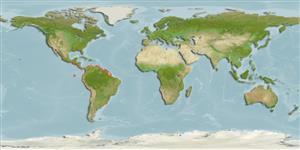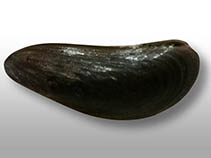Mytella charruana (d'Orbigny, 1847)
Charrua mussel| Native range | All suitable habitat | Point map | Year 2050 |

|
| This map was computer-generated and has not yet been reviewed. |
| Mytella charruana AquaMaps Data sources: GBIF OBIS |
Classification / Names Common names | Synonyms | CoL | ITIS | WoRMS
Bivalvia | Mytilida | Mytilidae | Mytilinae
Environment: milieu / climate zone / depth range / distribution range Ecology
Benthic; brackish. Tropical; 6°C - 30°C (Ref. 104793); 29°N - 41°S, 116°W - 46°W (Ref. 83435)
Distribution Countries | FAO areas | Ecosystems | Occurrences | Introductions
Eastern Pacific and Western Atlantic. Introduced in the southeast USA and Philippines.
Length at first maturity / Size / Weight / Age
Maturity: Lm 1.3 range ? - ? cm Max length : 5.0 cm DL male/unsexed; (Ref. 83435); 4.87 cm SHL (female)
Life cycle and mating behavior Maturity | Reproduction | Spawning | Eggs | Fecundity | Larvae
Main reference
References | Coordinator | Collaborators
Rosenberg, G. 2009 Malacolog 4.1.1: A Database of Western Atlantic Marine Mollusca. [WWW database (version 4.1.1)] URL http://www.malacolog.org/. (Ref. 83435)
IUCN Red List Status
(Ref. 130435: Version 2025-1)
CITES status (Ref. 108899)
CMS (Ref. 116361)
Threat to humans
Human uses
Fisheries: commercial
| FishSource |
Tools
More information
Max. ages / sizes
Length-weight rel.
Length-length rel.
Length-frequencies
Mass conversion
Abundance
Internet sources
BHL | BOLD Systems | CISTI | DiscoverLife | FAO(Publication : search) | Fishipedia | GenBank (genome, nucleotide) | GloBI | Gomexsi | Google Books | Google Scholar | Google | PubMed | Tree of Life | Wikipedia (Go, Search) | Zoological Record



